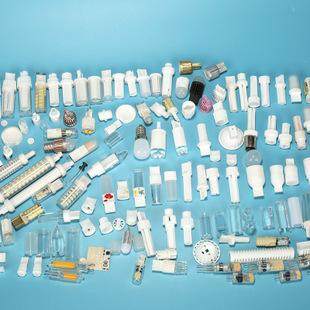Functional Ceramics Industry Overview
1.1 Definition
Functional ceramics are materials mainly used of their non-mechanical properties in application. These materials usually have one or more functions, such as electricity, magnetism, light, heat, chemistry, biology, etc. Some of them have coupling functions, such as piezoelectric, piezomagnetic, thermoelectric, electro-optic, acoustioptic, magneto-optic and so on.

1.2 Category
- Electronic ceramics, such as insulating ceramics, dielectric ceramics, ceramic capacitors, microwave ceramics, piezo ceramics, semiconductor ceramics, superconducting ceramics, magnetic levitation, etc.
- Thermal functional ceramics, such as heat-resistant ceramics, refractory ceramics, heat-conducting ceramics: heat dissipation elements, heat-insulating ceramics
- Optical functional ceramics, such as transparent ceramics, infrared radiant ceramics, luminescent ceramics
- Bioceramics, such as bioinert ceramics (artificial joints), bioactive ceramics (artificial bone materials), medical ceramics
- Chemical ceramics, such as ceramic for carrier (automobile exhaust catalytic carrier), catalytic ceramics, etc.
1.3 The course
Started in the 1930s, the functional ceramics went through a long-period process, the dielectric, piezoelectric, ferroelectric ceramic, semiconductor ceramics, high temperature superconducting ceramics, now are widely used in microelectronics technology, electronic technology, laser technology, automation technology, photoelectron technology, communications, environmental protection, energy, and biological medicine.
- In 1941, the USA firstly made barium titanate ferroelectric ceramics with dielectric constant as high as 1100.
- In 1947, BaTiO3 piezoelectric ceramics were made in USA, and various piezo ceramic devices were made in Japan.
- In 1955, W.Haayman found that when rare earth oxides were added to BaTiO3, the room temperature resistivity would be significantly reduced, which expanded the wide application of PTC materials.
- In the 1970s, Bryan and others(USA) first made microwave dielectric BaTi4O3 material with dielectric constant of 38.
- in 1986, Muller(Swizerland) and Bednorz(Germany) found that LaBaCuO oxide ceramics had high temperature superconductivity of 35K, breaking the acknowledge that “oxide ceramics are insulators”, and caused a stir.
Functional Ceramics Market Analyses
2.1 Global market shares
At present, Japan and United States lead the world in the research and development of functional ceramic materials and components.
Japan takes over the world more than 60% market share of functional ceramics;
USA leads in basic research and the development of new materials, and its products focus on High technology and military engineering, which are superior in acoustic, electro-optic, optoelectronics, infrared technology and semiconductor packaging and other areas.

2.2 Global market size analyses
• Advanced ceramics can be divided into structural ceramics and functional ceramics according to their characteristics and uses. Functional ceramics take 70% of the advanced ceramics market share, the rest for structural ceramics.
• With the continuous development of various functions of advanced ceramics, in the microelectronics industry, communication industry, automatic control and intelligent technology, the position of functional ceramics as supporting materials will be increased significant, and the market capacity will also improved in the future.
• In 2019, the global market size of advanced ceramics is about $83.3 billion, with an average annual growth rate of about 10%, which is expected to reach 2024 $134.6 billion. The market size corresponding to functional ceramics is about $58.3 billion in 2019.

2.3 Global electronic ceramics market size analyses
• Electronic ceramics are the most important type of functional ceramics, whose market share occupies a high proportion of the functional ceramics market.
• Statistics data show that the global market size of electronic ceramic materials is $23.38 billion in 2018, the estimated global market size of electronic ceramic is about $24.14 billion in 2019.

2.4 The market size of Electronic ceramics in China
Statistics data show that the market size of China's electronic ceramics (including materials and devices) is estimated to be around 57 billion yuan in 2018, and is estimated to reach 64.1 billion yuan in 2019.
Functional Ceramics Development Trend
3.1 miniaturization
• With the rapid development of 5G and satellite communication, the demand for miniaturization of devices is becoming more and more urgent. High-performance functional ceramic materials and their advanced preparation technology become an important research topic.
• High-frequency is the inevitable trend of digital 3C products. Functional ceramic materials with good high-frequency characteristics and serial working frequencies are the research hotspots in the field of new electronic components.
3.2 High-frequency and frequency serialization
• The development of low-temperature co-firing ceramic materials with excellent performance and advanced co-firing technology of heterogeneous materials become an important direction in the field of information functional ceramics.
3.3 Integration and modularization
• With the increasing trend of electronic information technology towards integration, thin, miniaturization and intelligence, the nanometer of functional ceramic materials has become an inevitable trend.
Functional Ceramics Development Proposal
4.1 In terms of performance
It should develop towards the direction of high performance, low cost, high reliability, multi-function and intelligence;
4.2 In terms of application
It should develop towards intelligent sensitive ceramic components, optical fiber ceramic materials for computers, computer hard disks and high-stability ceramic capacitors;
4.3 In terms of equipment technology
It should be developed towards low-temperature sintering, regulation, composite and miniaturization of nano-materials.
Declaration: This article is provided by CERADIR™ users or obtained from Internet, the content does not represent the position of CERADIR™. We are not responsible for the authenticity/accuracy of the article, especially the effects of the products concerned. This article is for study only, it does not constitute any investment or application advice. For reprinting, please contact the original author. If it involves the copyright and/or other issues, please contact us and we will deal with it asap! CERADIR™ has the interpretation of this declaration.







